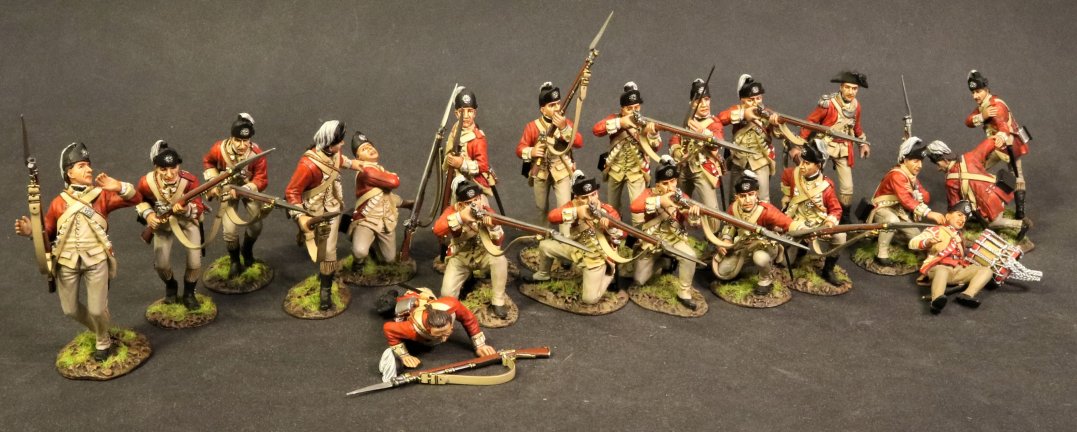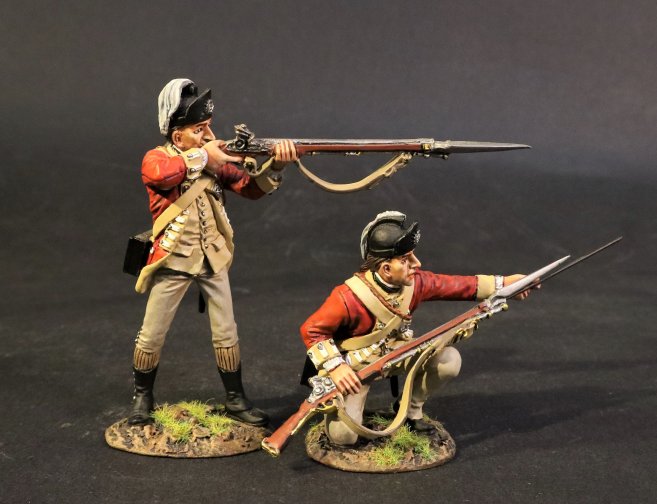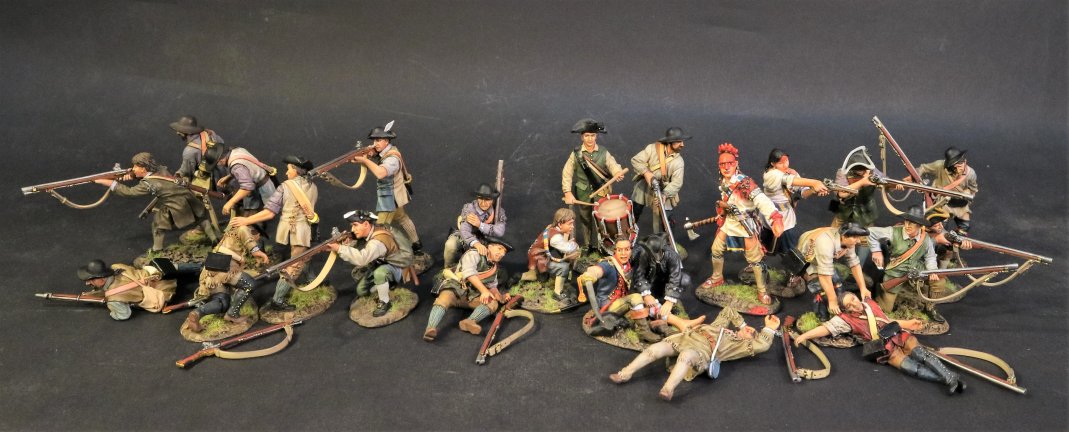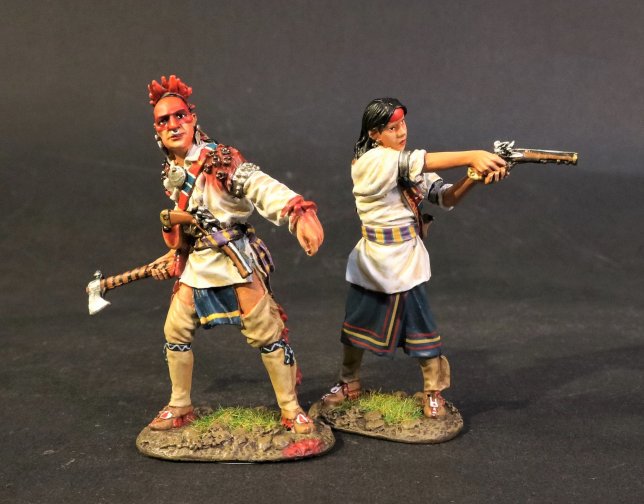- Joined
- Feb 2, 2011
- Messages
- 2,093
NEW RELEASES FOR NOVEMBER 2020
THE EIGHTEENTH CENTURY COLLECTION
DRUMS ALONG THE MOHAWK
THE BATTLE OF SARATOGA 1777,
THE BATTLE OF FREEMAN’S FARM, SEPTEMBER 19[SUP]th[/SUP] 1777
ANGLO-ALLIED ARMY

The 62nd Regiment of Foot was an infantry regiment of the British Army, which was raised in 1756 and saw service through the eighteenth and nineteenth centuries. Under the Childers Reforms it amalgamated with the 99th (Lanarkshire) Regiment of Foot to form the Wiltshire Regiment in 1881.
In October 1756 a second battalion to the 4th Regiment of Foot was formed as part of measures to strengthen the army at the start of the Seven Years' War with France.
In January 1758 four companies of the 2nd/4th Regiment embarked at Plymouth as Marines under Major T Hardy in five ships of Admiral Boscawen's fleet while Battalion Headquarters and the remaining companies stayed at Plymouth. The fleet sailed for Halifax, Nova Scotia, the base for a seaborne attack on French Canada. However, on 21 April while the fleet was part way across the Atlantic came news of a change of name following an official decree that the new second battalions throughout the Army would be numbered as separate regiments. Under this re-organisation the 2nd/4th Regiment became the 62nd Regiment of Foot.
Throughout the Canadian campaign the 62nd continued to serve as Marines, providing landing parties, manning ships' boats, putting artillery pieces ashore and providing local protection for them. During this time the Regiment won its first Battle Honour 'Louisburg' in 1758, but it was not awarded until 152 years later. The reason for this was that since they were employed on board ship the men were on the strength of the navy, not the army, so that at the time the War Office stated they had no record of the Regiment's participation!

S62-09
DRUMS ALONG THE MOHAWK,
THE BATTLE OF SARATOGA 1777,
THE ANGLO ALLIED ARMY,
THE 62[SUP]nd[/SUP] REGIMENT OF FOOT,
2 LINE INFANTRY.
(2 pcs)
The Regiment was still in Ireland when fighting broke out near Boston between the Colonists and British troops and an American force set out to conquer Canada in 1775. The 62nd sailed for Quebec the following year. The Regiment acted as Light Infantry and were involved in the advance from Canada into the rebel New England colonies under General Burgoyne. They won great praise for their steadfastness and fortitude in a number of actions.
On 19th August 1777, Burgoyne began a movement to encircle the American fortifications on Bemis Heights. Burgoyne’s intention was to take possession of the high ground to the west of the American fortifications and use the advantage of greater elevation to bombard the Americans from their flank.
Brigadier Fraser, with the British Right Wing, pushed into the woods along the northern side of a deep ravine. Hamilton followed him with the British Centre, accompanied by Burgoyne. Riedesel and his German troops remained on the riverside with the boats and supplies. Once in a line the three contingents would advance on the Americans.
Gates had no aggressive plan with which to counter the British move. He planned to await attack in his fortified position on Bemis Heights. His subordinate, Arnold, had no such intention. He was determined to take the fight to the advancing British and use the advantage his men had in forest fighting.
Arnold pressed Gates to attack with the whole army. Gates refused, but finally agreed that Arnold could take his own division forward against the British line.
Morgan’s riflemen were the first American troops to attack, launching an assault on a small force of Canadians and Indians of Fraser’s Right Wing. Morgan’s men were followed by Arnold’s division of New Hampshire Continentals.
As the Canadians and Indians fell back, Morgan’s riflemen rushed on in pursuit and were dispersed by a British counterattack.
The New Hampshire Continentals were repelled by Fraser’s Grenadiers and Light Companies.
A desperate battle developed between the attacking Americans and the regiments of the British Centre. During this fighting, which was described by veteran British soldiers as very heavy, General Phillips led a bayonet charge of the 20[SUP]th[/SUP] Regiment, to enable the 62[SUP]nd[/SUP] to withdraw and re-organise.
Gates, still in the American position on Bemis Heights, refused to commit further formations of the American army to the battle. If he had done so, it is generally accepted that the British Centre would have been overwhelmed.
At the battle of Freeman's Farm in the Saratoga campaign of 1777 the losses were so heavy that at the end only five officers and 60 men of the 62nd were fit for duty. Lack of reinforcements and supplies eventually caused General Burgoyne to surrender and the remaining members of the 62nd were taken prisoner. By 1780 most of the officers had been exchanged and were back home but few of the men ever saw England again.
PLEASE NOTE THIS IS THE FINAL RELEASE FOR THE 62[SUP]nd[/SUP] REGIMENT.
MANY THANKS TO HECTOR FOR REMINDING THAT THIS SET HAD NOT BEEN RELEASED.
THE BATTLE OF ORISKANY, 1777.

The Battle of Oriskany on August 6, 1777 was one of the bloodiest battles in the American Revolutionary War and a significant engagement of the Saratoga campaign. A party of Loyalists and several Indian allies ambushed an American military party that was trying to relieve the siege of Fort Stanwix. This was one of the few battles in which almost all of the participants were Americans; Patriots and allied Oneidas fought against Loyalists and allied Iroquois in the absence of British regular soldiers.
The Patriot relief force came from the Mohawk Valley under General Nicholas Herkimer and numbered around 800 men of the Tryon County militia plus a party of Oneida warriors. British commander Barry St. Leger authorized an intercepting force consisting of a Hanau Jäger (light infantry) detachment, Sir John Johnson's King's Royal Regiment of New York, Indian allies from the Six Nations, particularly Mohawks and Senecas and other tribes to the north and west, and Indian Department Rangers, totaling at least 450 men.
The Loyalist and Indian force ambushed Herkimer's force in a small valley about six miles (10 km) east of Fort Stanwix, near the village of Oriskany, New York. Herkimer was mortally wounded, and the battle cost the Patriots approximately 450 casualties, while the Loyalists and Indians lost approximately 150 dead and wounded. The result of the battle remains ambiguous. The apparent Loyalist victory was significantly affected by a sortie from Fort Stanwix in which the Loyalist camps were sacked, damaging morale among the allied Indians.
The battle also marked the beginning of a war among the Iroquois, as Oneida warriors under Colonel Louis and Han Yerry allied with the American cause. Most of the other Iroquois tribes allied with the British, especially the Mohawks and Senecas.

DAM-20
DRUMS ALONG THE MOHAWK,
THE BATTLE OF ORISKANY, August 6[SUP]th[/SUP] 1777,
THE ONEIDA,
HAN YERRY TEHAWENGARAGWEN,
AND SARA TYONAJANEGER.
(2 pcs)
In July and August 1775 Herkimer headed the Tryon County Committee of Safety, and became colonel of the district militia. After the split in which Loyalist militia members from the area withdrew to Canada, he was commissioned a brigadier general in the Tryon County militia by the Provincial Congress on September 5, 1776. In June 1776, he led 380 men of the Tryon County militia to confront Joseph Brant (Mohawk) at Unadilla, New York. Herkimer asked the Mohawk and five other Iroquois nations to remain neutral, while Brant said the Indians owed their loyalty to the King.
When Herkimer learned of the siege of Fort Stanwix to the west in late July 1777, he ordered the Tryon County militia to assemble at Fort Dayton. He marched them out to Fort Stanwix, about 28 miles to the west. His force marching in column was ambushed on August 6 by a mixed force of British regulars, Tory militia, and Mohawk in the Battle of Oriskany. Herkimer's horse was shot, and he was seriously wounded in the leg. In spite of his injuries, he sat propped up against a tree, lit his pipe, and directed his men in the battle, rallying them to avoid two panicked retreats. When they withdrew, they carried him home.
The brigade surgeon, William Petrie, dressed Herkimer's wound in the field and placed him on a litter. The wound quickly became infected, but the decision to amputate the leg was delayed for about ten days after the battle. The operation was performed by an inexperienced surgeon, Robert Johnson, because Petrie had also been wounded in the battle and was not available. The operation went poorly, the wound bled profusely, and Herkimer died of the injury on August 16, at around the age of 49.
** PLEASE CONTACT YOUR LOCAL DEALER FOR FURTHER INFORMATION **
THE EIGHTEENTH CENTURY COLLECTION
DRUMS ALONG THE MOHAWK
THE BATTLE OF SARATOGA 1777,
THE BATTLE OF FREEMAN’S FARM, SEPTEMBER 19[SUP]th[/SUP] 1777
ANGLO-ALLIED ARMY

The 62nd Regiment of Foot was an infantry regiment of the British Army, which was raised in 1756 and saw service through the eighteenth and nineteenth centuries. Under the Childers Reforms it amalgamated with the 99th (Lanarkshire) Regiment of Foot to form the Wiltshire Regiment in 1881.
In October 1756 a second battalion to the 4th Regiment of Foot was formed as part of measures to strengthen the army at the start of the Seven Years' War with France.
In January 1758 four companies of the 2nd/4th Regiment embarked at Plymouth as Marines under Major T Hardy in five ships of Admiral Boscawen's fleet while Battalion Headquarters and the remaining companies stayed at Plymouth. The fleet sailed for Halifax, Nova Scotia, the base for a seaborne attack on French Canada. However, on 21 April while the fleet was part way across the Atlantic came news of a change of name following an official decree that the new second battalions throughout the Army would be numbered as separate regiments. Under this re-organisation the 2nd/4th Regiment became the 62nd Regiment of Foot.
Throughout the Canadian campaign the 62nd continued to serve as Marines, providing landing parties, manning ships' boats, putting artillery pieces ashore and providing local protection for them. During this time the Regiment won its first Battle Honour 'Louisburg' in 1758, but it was not awarded until 152 years later. The reason for this was that since they were employed on board ship the men were on the strength of the navy, not the army, so that at the time the War Office stated they had no record of the Regiment's participation!

S62-09
DRUMS ALONG THE MOHAWK,
THE BATTLE OF SARATOGA 1777,
THE ANGLO ALLIED ARMY,
THE 62[SUP]nd[/SUP] REGIMENT OF FOOT,
2 LINE INFANTRY.
(2 pcs)
The Regiment was still in Ireland when fighting broke out near Boston between the Colonists and British troops and an American force set out to conquer Canada in 1775. The 62nd sailed for Quebec the following year. The Regiment acted as Light Infantry and were involved in the advance from Canada into the rebel New England colonies under General Burgoyne. They won great praise for their steadfastness and fortitude in a number of actions.
On 19th August 1777, Burgoyne began a movement to encircle the American fortifications on Bemis Heights. Burgoyne’s intention was to take possession of the high ground to the west of the American fortifications and use the advantage of greater elevation to bombard the Americans from their flank.
Brigadier Fraser, with the British Right Wing, pushed into the woods along the northern side of a deep ravine. Hamilton followed him with the British Centre, accompanied by Burgoyne. Riedesel and his German troops remained on the riverside with the boats and supplies. Once in a line the three contingents would advance on the Americans.
Gates had no aggressive plan with which to counter the British move. He planned to await attack in his fortified position on Bemis Heights. His subordinate, Arnold, had no such intention. He was determined to take the fight to the advancing British and use the advantage his men had in forest fighting.
Arnold pressed Gates to attack with the whole army. Gates refused, but finally agreed that Arnold could take his own division forward against the British line.
Morgan’s riflemen were the first American troops to attack, launching an assault on a small force of Canadians and Indians of Fraser’s Right Wing. Morgan’s men were followed by Arnold’s division of New Hampshire Continentals.
As the Canadians and Indians fell back, Morgan’s riflemen rushed on in pursuit and were dispersed by a British counterattack.
The New Hampshire Continentals were repelled by Fraser’s Grenadiers and Light Companies.
A desperate battle developed between the attacking Americans and the regiments of the British Centre. During this fighting, which was described by veteran British soldiers as very heavy, General Phillips led a bayonet charge of the 20[SUP]th[/SUP] Regiment, to enable the 62[SUP]nd[/SUP] to withdraw and re-organise.
Gates, still in the American position on Bemis Heights, refused to commit further formations of the American army to the battle. If he had done so, it is generally accepted that the British Centre would have been overwhelmed.
At the battle of Freeman's Farm in the Saratoga campaign of 1777 the losses were so heavy that at the end only five officers and 60 men of the 62nd were fit for duty. Lack of reinforcements and supplies eventually caused General Burgoyne to surrender and the remaining members of the 62nd were taken prisoner. By 1780 most of the officers had been exchanged and were back home but few of the men ever saw England again.
PLEASE NOTE THIS IS THE FINAL RELEASE FOR THE 62[SUP]nd[/SUP] REGIMENT.
MANY THANKS TO HECTOR FOR REMINDING THAT THIS SET HAD NOT BEEN RELEASED.
THE BATTLE OF ORISKANY, 1777.

The Battle of Oriskany on August 6, 1777 was one of the bloodiest battles in the American Revolutionary War and a significant engagement of the Saratoga campaign. A party of Loyalists and several Indian allies ambushed an American military party that was trying to relieve the siege of Fort Stanwix. This was one of the few battles in which almost all of the participants were Americans; Patriots and allied Oneidas fought against Loyalists and allied Iroquois in the absence of British regular soldiers.
The Patriot relief force came from the Mohawk Valley under General Nicholas Herkimer and numbered around 800 men of the Tryon County militia plus a party of Oneida warriors. British commander Barry St. Leger authorized an intercepting force consisting of a Hanau Jäger (light infantry) detachment, Sir John Johnson's King's Royal Regiment of New York, Indian allies from the Six Nations, particularly Mohawks and Senecas and other tribes to the north and west, and Indian Department Rangers, totaling at least 450 men.
The Loyalist and Indian force ambushed Herkimer's force in a small valley about six miles (10 km) east of Fort Stanwix, near the village of Oriskany, New York. Herkimer was mortally wounded, and the battle cost the Patriots approximately 450 casualties, while the Loyalists and Indians lost approximately 150 dead and wounded. The result of the battle remains ambiguous. The apparent Loyalist victory was significantly affected by a sortie from Fort Stanwix in which the Loyalist camps were sacked, damaging morale among the allied Indians.
The battle also marked the beginning of a war among the Iroquois, as Oneida warriors under Colonel Louis and Han Yerry allied with the American cause. Most of the other Iroquois tribes allied with the British, especially the Mohawks and Senecas.

DAM-20
DRUMS ALONG THE MOHAWK,
THE BATTLE OF ORISKANY, August 6[SUP]th[/SUP] 1777,
THE ONEIDA,
HAN YERRY TEHAWENGARAGWEN,
AND SARA TYONAJANEGER.
(2 pcs)
In July and August 1775 Herkimer headed the Tryon County Committee of Safety, and became colonel of the district militia. After the split in which Loyalist militia members from the area withdrew to Canada, he was commissioned a brigadier general in the Tryon County militia by the Provincial Congress on September 5, 1776. In June 1776, he led 380 men of the Tryon County militia to confront Joseph Brant (Mohawk) at Unadilla, New York. Herkimer asked the Mohawk and five other Iroquois nations to remain neutral, while Brant said the Indians owed their loyalty to the King.
When Herkimer learned of the siege of Fort Stanwix to the west in late July 1777, he ordered the Tryon County militia to assemble at Fort Dayton. He marched them out to Fort Stanwix, about 28 miles to the west. His force marching in column was ambushed on August 6 by a mixed force of British regulars, Tory militia, and Mohawk in the Battle of Oriskany. Herkimer's horse was shot, and he was seriously wounded in the leg. In spite of his injuries, he sat propped up against a tree, lit his pipe, and directed his men in the battle, rallying them to avoid two panicked retreats. When they withdrew, they carried him home.
The brigade surgeon, William Petrie, dressed Herkimer's wound in the field and placed him on a litter. The wound quickly became infected, but the decision to amputate the leg was delayed for about ten days after the battle. The operation was performed by an inexperienced surgeon, Robert Johnson, because Petrie had also been wounded in the battle and was not available. The operation went poorly, the wound bled profusely, and Herkimer died of the injury on August 16, at around the age of 49.
** PLEASE CONTACT YOUR LOCAL DEALER FOR FURTHER INFORMATION **

